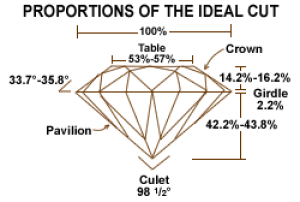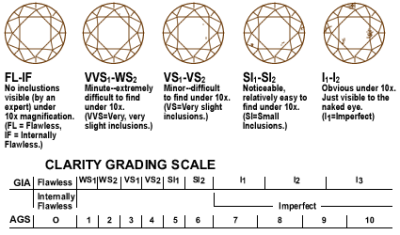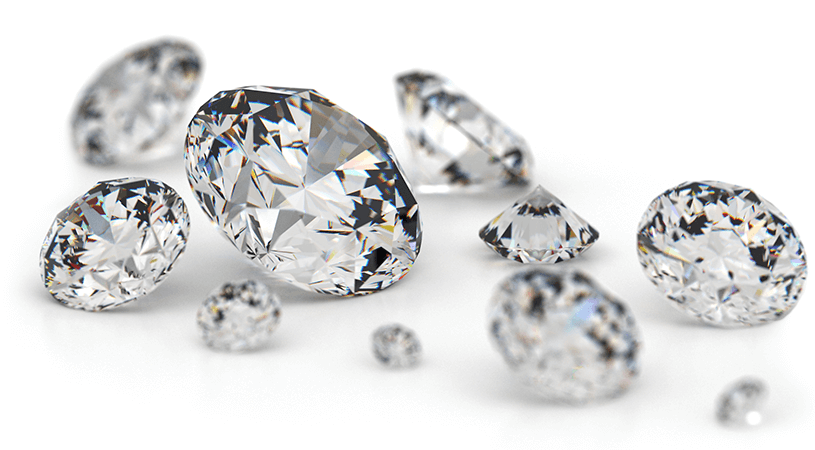Diamonds
Valued above all other precious gems, the quality of a natural diamond is judged on the basis of four characteristics – color, clarity, carat, and cut – commonly referred to as the “four C’s.”
Generally speaking, no one characteristic is more important than another. It is the interplay of all four “C’s” that determines each individual stone’s unique beauty. And, while nature determines the color and clarity of a stone, the cut of a diamond is dependent solely on the skill of the cutter.
PURCHASING DIAMONDS
Choosing a diamond is not an exact science. It is extremely important to personally view a diamond with the assistance of a trained professional. Purchasing a diamond sight unseen (via the Internet, for example) can result in disappointment.
Every diamond is unique and has varied characteristics that make it special. Subtle differences can significantly affect its value and price. Unless you are a qualified diamond expert, it is wise to purchase your diamond from a reputable, credentialed jeweler.
CERTIFIED DIAMONDS
The best diamonds are those that have been graded by distinguished laboratories such as the Gemological Institute of America (GIA), European Gemological Laboratory (EGL), and the American Gem Society (AGS).
A Certified Diamond report provides a diagram of the diamond, showing the placement, type, and size of the inclusions (relative to the diagram size). All diamond certificates bear the grades and measurements of the four C’s, most using the grading system devised by the G.I.A., a non-profit institution that is the standard in the world wide.
A grading report is requisite to prudent diamond purchasing. It provides authentication and adds significant value to your diamond.
Most Certified Diamond certificates offer two clarity diagrams: one of the diamond crown-side and pavilion-side up. Another shows the natural inclusions (as seen under 10X magnification), marked in different colors.
Most certificates also indicate whether a diamond fluoresces (glows blue) under ultraviolet – an undesirable quality to many, but relatively unimportant to others.
Ideal Cut

The “Ideal Cut” diamond is a round brilliant diamond that has been cut to exact proportions. With 58 precisely placed facets, its symmetry produces the ultimate in luster and beauty.
A round brilliant diamond cut to “ideal” proportions by a master cutter is a splendor to behold. All of the light entering the diamond from any direction is totally reflected through the top and dispersed in a display of sparkling flashes and rainbow colors.
When a round brilliant diamond has been cut to "Ideal" proportions by a master cutter, it is a splendor to behold. The Ideal Cut Diamond that has been cut to exact and mathematically proven proportions. Its symmetry, with 58 exactly placed facets, produces the ultimate in luster and beauty.
When a diamond is cut to the ideal proportions, all of the light entering from any direction is totally reflected through the top and is dispersed into a display of sparkling flashes and rainbow colors.
Colors


While most diamonds appear to be colorless, virtually all have slight traces of color (typically yellow or brown). For grading purposes, a diamond is evaluated by measuring the degree to which a diamond approaches colorlessness.
The color of a diamond is described using a letter scale, beginning with D through F (colorless), G through J (near colorless), and moving through the alphabet to Z. Color grades of D, E, and F are rarer and, therefore, more expensive.
Nevertheless, well-cut diamonds – with good clarity – of all color grades can be equally dazzling. Deeply colored diamonds in shades of pink, blue, and yellow are known as “fancies” and considered especially rare and valuable.
Most diamonds, although appearing colorless, actually have slight tones of yellow or brown. As these tones become more apparent, the rarity and the cost decrease.
Ideal cutting dramatizes the rare splendor of a diamond because it produces such dazzling brilliance.
Clarity

While most diamonds appear to be colorless, virtually all have slight traces of color (typically yellow or brown). For grading purposes, a diamond is evaluated by measuring the degree to which a diamond approaches colorlessness.
The color of a diamond is described using a letter scale, beginning with D through F (colorless), G through J (near colorless), and moving through the alphabet to Z. Color grades of D, E, and F are rarer and, therefore, more expensive.
Nevertheless, well-cut diamonds – with good clarity – of all color grades can be equally dazzling. Deeply colored diamonds in shades of pink, blue, and yellow are known as “fancies” and considered especially rare and valuable.
Most diamonds, although appearing colorless, actually have slight tones of yellow or brown. As these tones become more apparent, the rarity and the cost decrease.
Ideal cutting dramatizes the rare splendor of a diamond because it produces such dazzling brilliance.
Carat
The weight of a diamond is measured in carats. One carat is equal to .20 grams. A carat is then subdivided into 100 parts called “points”, for example:
One carat = 100 points
3/4 carat = 75 points
1/2 carat = 50 points
1/4 carat = 25 points
...etc.
Please note that carat weight is not equivalent to “size”. A diamond may appear to be larger or smaller, depending on its shape and cut.

Cut

“Cut” should not be confused with “shape”. A well-cut diamond, regardless of shape, releases its fire and brilliance through the proportions of its facets, allowing the maximum amount of light to be reflected.
A diamond that is cut too shallow permits too much light to pass through the bottom of the stone. Brilliance is lost, and the diamond appears watery, glassy, and dark.
Conversely, a diamond that is cut too deep allows light to escape from the sides of the stone, resulting in a similarly dull appearance and a dark center.
It is worth repeating that nature determines the color and clarity of a stone, but the cut of a diamond is dependent solely on the skill of the cutter.


